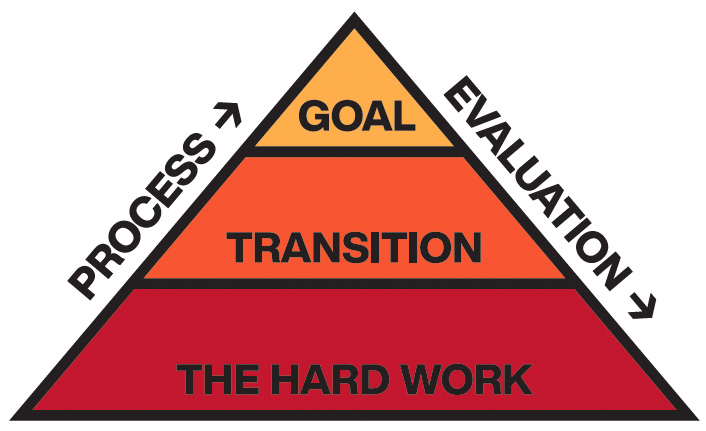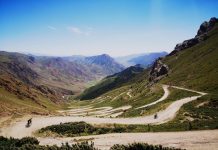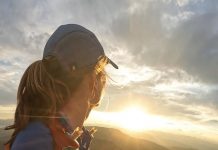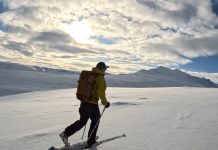We start each day with a mountain to climb and for many of us, the start of a mountain is the hardest part. Why? The summit is so far off that the difficulties we face on these lower slopes seem hopeless and our brain keeps telling us “wow it’s too far”- this in turn makes us even more aware of what our body is going through (yep hard work), it’s steep and we haven’t really warmed up so it feels even harder. Add to this that the views are not that great at the bottom either.
When we add physical discomfort and mental anguish together it’s not long before we stop and head home.
We can relate these lower slopes to our base training or to the start of a new project or for people who are feeling depressed just getting up each day.
If we chose to embrace this low level hard work and tell our brain to give us a moment, we find that the way out of this section is not that far off and in fact if we can trick our brain into accepting that the second phase of this mountain is really rewarding- we often find we can dull the noise and dull the discomfort.
How do we do this?
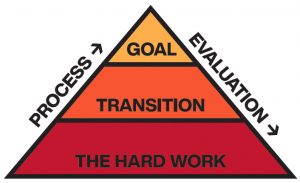
To explain how we simplify things, Dr Steve Peters would say we give our Chimp a banana, just like telling a human to put one foot in front of the other for 5 minutes and see where we are- it’s simple and gives something manageable to focus on.
We can pick an interesting point a little further ahead and make that our short-term focus. We can do a treat reward (yes even out in the wild we do this) could be a drink or food bar- something that acts as a positive distraction. Onwards we go using these methods until we hit the next phase.
In training terms, we can use data- how long did it take me to get to that point? What was my heart rate?
In our day to day life we can use the treats methods, get up clean up and then have your coffee (yep make your coffee your reward). Things that you normally just do and take for granted you put a challenge in front of, you are incentivising your basic activities until like on the mountain you just start to move forward naturally.
When we reach this second phase of the day/mountain/training, we are greeted with a reward, the view is amazing, the switch backs as we head up get shorter, making it is easier for our brains to focus and see a rest point. By now it has got steeper, but the reward to effort ratio has improved, added to which that summit has now become close enough to act as a magnet.
We find that we don’t need to rely on tricking or treating at this point as we have a natural instinctual motivation. The key is that we are starting to experience the enjoyment of moments and this becomes self-fulfilling.
The third phase is just below our summit/start line/successful day. Now we are tired, its really steep but we can see the outcome and let’s be honest the struggle at this point is so rewarding, we are actually enjoying the fight and we push on through and reach our summit.
This model has two more key areas to it. Firstly, our summit or our goal is important, but what’s even more important is your journey.

The reason that summit is so good is because you got through “the hard work” you got through the “transition” and in each of these processes you learned, you grew and you moved forward. These are the parts of the journey that define you as a person and teach you what you need to help go and reach more summits.
All too often we look for the short cut to the summit, then what do we have? A nice view and that’s it, no more than a view, no learnt experience through hardship, just a view.
Our modern lives are being built around this straight to summit mentality and this in turn weakens us as people. The “hard work” is not a place to be afraid of but to be embraced, “transition” should always be seen as a positive place to be, it’s your first step to your summit.
Your process and journey are so important that in fact your goal- your summit, becomes less important, to the point that if we don’t make it to the peak, it’s ok… why is it ok? Well look at all you have been through all you have learned. If the summit is important enough you will go back, you will be so much stronger and ready for it.
The second extra and really important part of this model is. “Evaluation”. Once we reach any summit (or no summit) we must evaluate; picking apart our process, seeing what areas were strong, where the weakest part was and how it was overcome, can I improve how I got past that.
We take this evaluation process seriously when on a real mountain and we should in training and life, why? Because when you get up tomorrow and start that mountain again you have more tools in your backpack to help you through the “hard work” more ways to enjoy the “transition” and so you summit stronger and better than before.
Obviously, if we look at mountains, they are all different and can present many different challenges. Sometimes our tools will be useless, but what won’t be is your mindset. You’ve been here before at the foot of a mountain without the tools, so you have one important item in your backpack, confidence! That belief that it may be hard but you can get through and you can reach those rewarding views.
Confidence sometimes has to be dug out; we need to pull out our past experience to believe we can do things. Don’t be afraid to go dig that out, you worked for it and earned it, so use it and the more of these summits, processes and goals you achieve, the less you will have to dig and so your confidence will grow.
Walking away from the mountain is never a negative. I personally have even been at the bottom of a mountain that I have climbed many times but for some reason I cannot get things to align. I know I can do it but my heads not there, or my legs are too tired. On these days we walk away strong knowing we have done it before and we will be back and we will do it again- today is just not the day.
Accepting these days is really important, not letting them be a negative but just part of your process.

